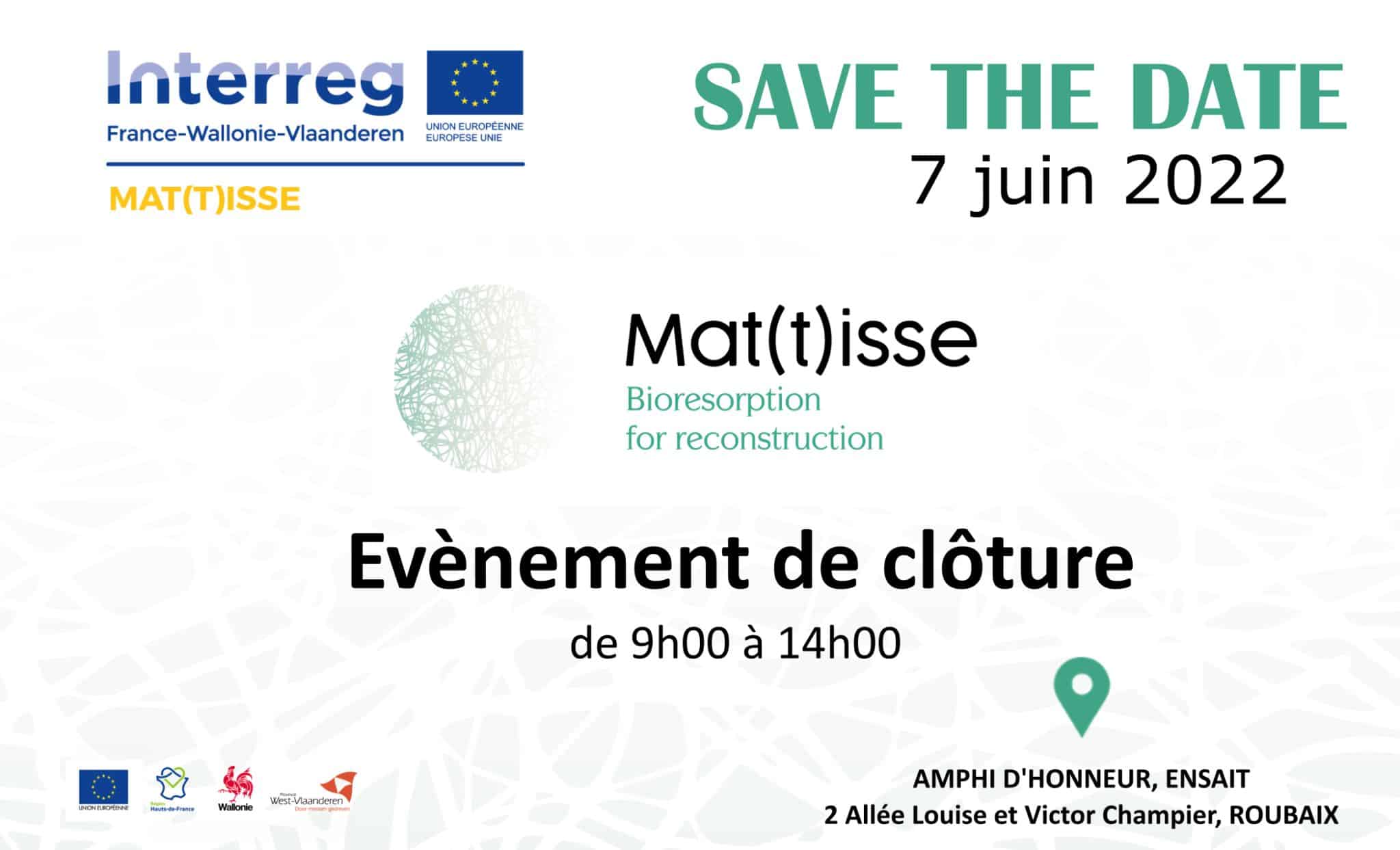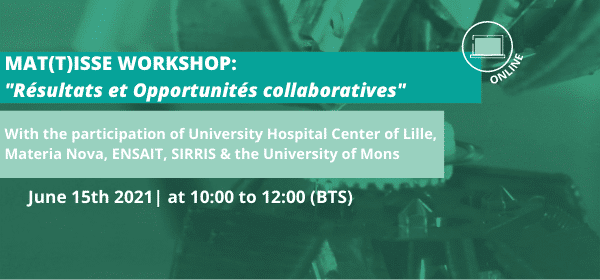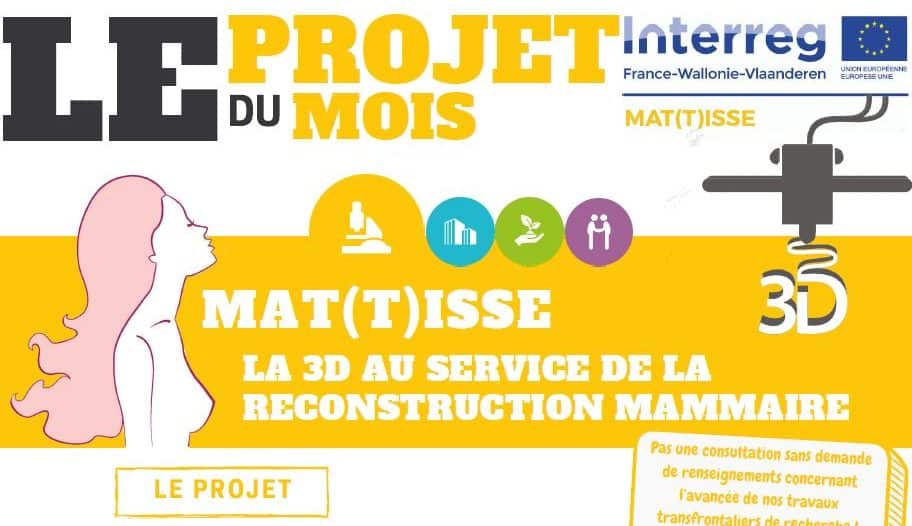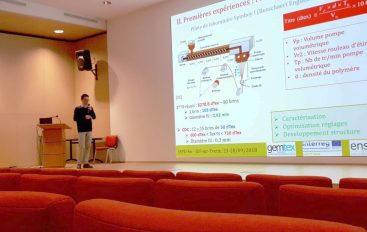THE PROJECT
MAT(T)ISSE AT A GLANCE
MAT(T)ISSE project aims at designing a new bioprosthesis, a class 3 implantable medical device, which helps the body restore damaged or removed tissues (e.g. after curative surgery).
The tissue regeneration process is enabled by sampling adipose tissue and then re-implanted in-situ, onto a synthetic and absorbable lace-like textile support. The latter promotes fat cells multiplication and colonisation as well as tissue revascularisation. This textile support is topped with a 3D-printed shell that boun
MAT(T)ISSE project aims at designing a new bioprosthesis, a class 3 implantable medical device, which helps the body restore damaged or removed tissues (e.g. after curative surgery).
The tissue regeneration process is enabled by sampling adipose tissue and then re-implanted in-situ, onto a synthetic and absorbable lace-like textile support. The latter promotes fat cells multiplication and colonisation as well as tissue revascularisation. This textile support is topped with a 3D-printed shell that bounds and shapes the volume to be regenerated.
Eventually, the bioprosthesis resorbs itself and only the regenerated adipose tissue forming the breast remains.
ds and shapes the volume to be regenerated.
Eventually, the bioprosthesis resorbs itself and only the regenerated adipose tissue forming the breast remains.
Start date: 01/01/2018
End date: 30/06/2022
Total budget: € 2,995,501.50
GOALS
To overcome the disadvantages of both non-autologous and autologous reconstruction techniques, we design a new and personalised bioresorbable prosthesis taking the best of both techniques.
Our new breast reconstruction protocol is based upon the sampling and re-implantation of smaller autologous adipose tissues, paired with a resorbable implant allowing breast reconstruction to be performed in a single surgical intervention.
This implant consists of a cell growth support (lace) as well as a 3D-printed shell made of the same bioresorbable material. Additive manufacturing techniques now offers, based on MRI scans, the possibility to design personalised bioprosthesis, adapted to patients’ morphologies.
Fat tissues from the patient are positioned on the textile support, under the shell that will guide the reconstruction for 6 to 8 weeks. As soon as the volume of the shell is filled, the whole prosthesis is resorbed, resulting in a completely natural reconstructed breast.
The aim of the partnership is to enable a larger number of patients to have access to breast reconstruction, after a mastectomy. The advantages of the proposed technique are multiple: resorption of the implant, autologous technique, personalisation of the reconstruction, unique surgical intervention and a reduction in health costs for the patients.
THE MAT(T)ISSE CHALLENGE
Europe is one of the most affected world region by breast cancer. 1 in 8 European women will be affected by breast cancer in her life.
The most common surgery to cure breast cancer is the partial or total mastectomy, which concerns up to 73% of diagnosed patients. This surgery has significant consequences for the patient: from loss of self-esteem, sexual difficulties to the mourning of her former body.
Only 20% of these patients benefit from a breast reconstruction. There are currently three main techniques for breast reconstruction: silicone breast prosthesis, autologous transfer of a large vascularised flaps from the lower abdomen or the thigh (DIEP) and the autologous transfer of non-vascularised fatty cells (lipofilling).
These three techniques have drawbacks. For example, silicon prostheses are foreign bodies and thus can be at risk. That is the reason why Belgium and France have recommended the removal of PIP prostheses after 2010 scandal. Therefore, existing techniques do not perfectly meet patients and surgeons’ needs and requirements. Alternative and innovative solutions must be found.
The challenge for Mat(t)isse is to design a solution capable of first promoting the adipose tissue regeneration and filling of the volume to be reconstructed and then able of being safely resorbed.
To this end, we combined skills and knowledges from multidisciplinary research teams, doctors and engineers from both sides of the Franco-Belgian border.
Materia Nova (Mons) develops new biomaterials, Ecole Nationale Supérieure des Arts et Industries Textiles (Roubaix) implements industrial-quality yarns, University of Mons studies cellular mechanics and interfaces between cells and materials, SIRRIS modes and prints the bioprosthesis, and Lille University Hospital (coordinator) check biocompatibility and carries out first preclinical tests. Euramaterials and Eurasanté are ensuring the dissemination of project’s achievements to companies across France and Belgium, do not hesitate to contact them!
STRATEGY AND ACTIONS
To achieve this objective, the MAT(T)ISSE project is articulated around 4 main actions:
1) The screening of resorbable biomaterials and definition of implementation and resorption protocols
2) The implementation of innovative biomaterials: resorbable and biocompatible polymers, yarns and laces but also 3D-printed shells
3) The preclinical validation of the prosthesis through in vitro and in vivo trials (Lille University Hospital)
4) The modelling of MAT(T)ISSE project’s medical device, to provide personalised 3D prostheses.
MAT(T)ISSE project focuses on breast application, but the partners also consider other medical applications (therapeutic and aesthetic surgery) as the know-how developed along the project could be transposed to reconstruction of other parts of the body (face, buttocks…).
INNOVATION

TECHNOLOGY
MAT(T)ISSE project aims at designing a new bioprosthesis, a 3rd class implantable medical device, which helps the body restore damaged or removed tissues (e.g. after curative surgery). This tissue repair is done by autologous sampling of vascularised fatty cells then deposited onto a synthetic and absorbable lace-like textile structure.
This structure is paired with a customised and bioresorbable 3D-printed shell which delimits and protects the volume to be reconstructed.

RESEARCH
The MAT(T)ISSE consortium is working with new bioresorbable and bio-compatible materials, processed into yarns, lace or customised 3D-printed implantable supports. These structures are then undergoing biological and medical validations through in vitro trials and implantation protocols.

NETWORK
Project partners are particularly committed to the communication of project’s results to a large audience and especially to patients and patient associations, to make sure patients’ needs are met.
LATEST NEWS FROM MAT(T)ISSE
SAVE THE DATE : CLOSING EVENT
07/06/2022 – 9:00 to 14:00 – AMPHI D’HONNEUR, ENSAIT, 2 allée Louise et Victor Champier, ROUBAIX
The MAT(T)ISSE project will come to an end in June 2022, and the closing event on 7 June 2022 will be an opportunity to look back at all the advances that have been made by the consortium members and to discuss with them the scientific and medical opportunities that MAT(T)ISSE
has to offer.
JUNE 15, 2021: DIGITAL WORKSHOP ” RÉSULTATS ET OPPORTUNITÉS COLLABORATIVES ” (in French)
This first dissemination workshop was an opportunity to review the results achieved by the MAT(T)ISSE project partners and discuss collaborative opportunities. Representatives of the University Hospital of Lille (project leader), Materia Nova, ENSAIT, SIRRIS and the University of Mons reviewed their work and discussed the prospects that the results of the MAT(T)ISSE project offer.
DECEMBER 10, 2020: DIGITAL WORKSHOP MAT(T)ISSE AND 3D4MED
MAT(T)ISSE and 3D4Med projects are organising a workshop entitled “3D printing as a promising technique for tissue regeneration: towards 4D printing?” which will take place during the 4th MedFIT business convention.
MAT(T)ISSE: PROJECT OF THE MONTH
On the occasion of World Cancer Day, MAT(T)ISSE features as the “project of the month” of February 2020 infographics designed by Interreg France-Wallonie-Vlaanderen.
26 JUNE 2019: MAT(T)ISSE WILL BE ON MEDFIT
MAT(T)ISSE partners will be present at MedFIT, the European event dedicated to partnership innovation in the medical, diagnostic and digital technology sector, on 26th of June 2019.
Come and meet them around a workshop on the theme of implants!
FROM 23 TO 28 SEPTEMBER 2018 : MAT(T)ISSE AT THE POLYMER STUDY DAYS
Vivien Barral, a doctoral student at ENSAIT, presented his research work in the context of the cross-border Interreg projet Mat(t)isse, at the 46th polymer study days, in Gif-sur-Yvette. It was an opportunity to present the results of studies of polymer blends with a view to the production of absorbable yarns (spinnability, morphology of the blends).
MAT(T)ISSE LAUNCH COMMITTEE
On the 16th of April 2018, the MAT(T)ISSE project partners officially launched the MAT(T)ISSE project for a 4-year period. The Lille University Hospital, project leader, welcomed partners at the Institut Coeur Poumon of Lille to remind partners about ambitions and complementarity of them all. The Interreg France-Wallonie-Vlaanderen technical team, also attending, met all the partners and explained the rules and procedures of this cross-border programme.
PARTNERS
TO ADRESS THIS CHALLENGE, THE CROSS-BORDER PARTNERSHIP GATHERS INTERNATIONALLY RENOWNED AND COMPLEMENTARY PARTNERS:
CONTACT
LEAD PARTNER :
Lille University Hospital
Project leader : Pierre-Marie Danzé
Project officer: François Sihrener



















